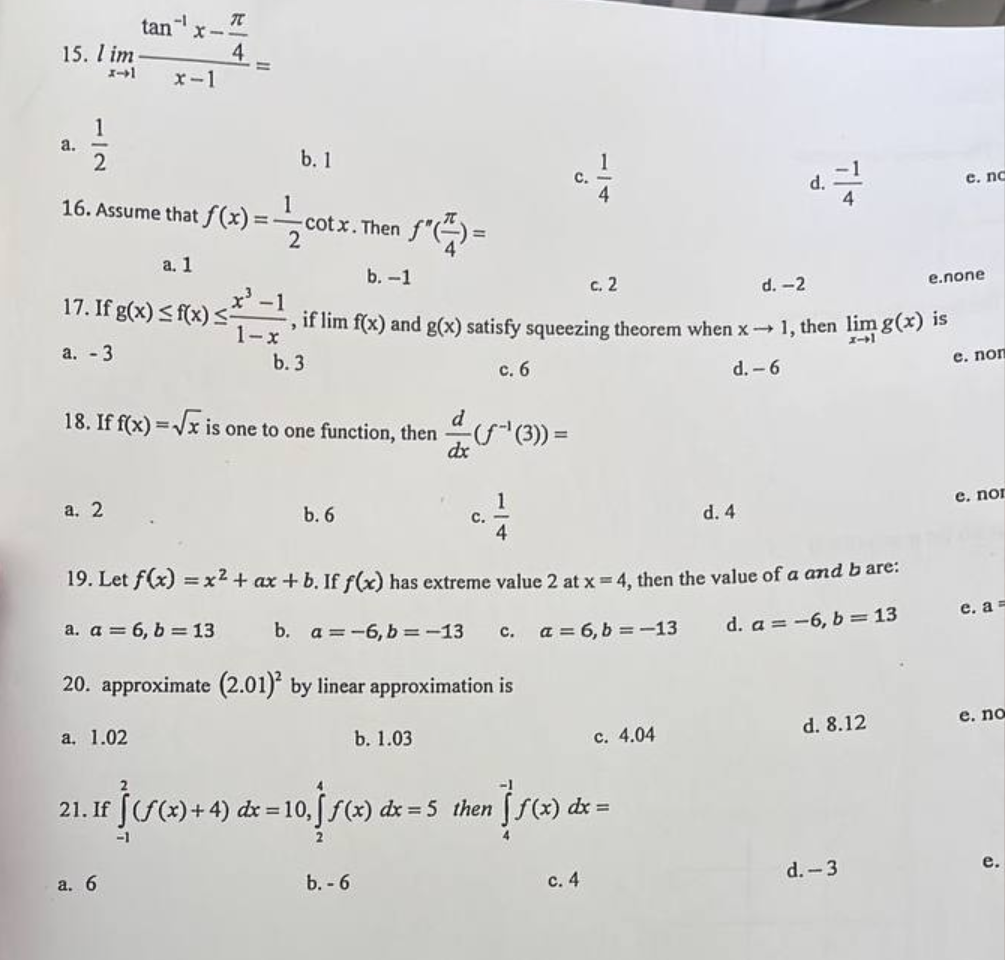15. l im x-1 a. 1 2 tan a. 2 -1 16. Assume that f(x) = a. 1 17. If g(x) ≤ f(x) ≤ a. - 3 x-1 a. 1.02 T 4 a. 6 1 b. 1 -1 1-x - cotx. Then 2 d 18. If f(x)=√x is one to one function, then 1*4)= b. -1 d. -2 > if lim f(x) and g(x) satisfy squeezing theorem when x→ 1, then lim g(x) is b. 3 e. non c. 6 d. -6 b. 6 b. - 6 -(ƒ~¹ (3)) = b. 1.03 dx C. 19. Let f(x) = x² + ax + b. If f(x) has extreme value 2 at x = 4, then the value of a and b are: a. a = 6, b= 13 b. a = -6, b = -13 d. a = -6, b=13 20. approximate (2.01)² by linear approximation is C. c. 2 a = 6, b = -13 21. If If ƒ‹ƒ(x) + 4) dx = 10, †ƒ(x) dx = 5 then f(x) dx = -1 c. 4 c. 4.04 d. d. 4 d. 8.12 e. nc d.-3 e.none e. nor e. a e. no e.
15. l im x-1 a. 1 2 tan a. 2 -1 16. Assume that f(x) = a. 1 17. If g(x) ≤ f(x) ≤ a. - 3 x-1 a. 1.02 T 4 a. 6 1 b. 1 -1 1-x - cotx. Then 2 d 18. If f(x)=√x is one to one function, then 1*4)= b. -1 d. -2 > if lim f(x) and g(x) satisfy squeezing theorem when x→ 1, then lim g(x) is b. 3 e. non c. 6 d. -6 b. 6 b. - 6 -(ƒ~¹ (3)) = b. 1.03 dx C. 19. Let f(x) = x² + ax + b. If f(x) has extreme value 2 at x = 4, then the value of a and b are: a. a = 6, b= 13 b. a = -6, b = -13 d. a = -6, b=13 20. approximate (2.01)² by linear approximation is C. c. 2 a = 6, b = -13 21. If If ƒ‹ƒ(x) + 4) dx = 10, †ƒ(x) dx = 5 then f(x) dx = -1 c. 4 c. 4.04 d. d. 4 d. 8.12 e. nc d.-3 e.none e. nor e. a e. no e.
Linear Algebra: A Modern Introduction
4th Edition
ISBN:9781285463247
Author:David Poole
Publisher:David Poole
Chapter6: Vector Spaces
Section6.5: The Kernel And Range Of A Linear Transformation
Problem 30EQ
Related questions
Question
pleasssse solve questionnnnnn 15

Transcribed Image Text:15. l im
x-1
a.
1
2
tan
a. 2
-1
16. Assume that f(x) =
a. 1
17. If g(x) ≤ f(x) ≤
a. - 3
x-1
a. 1.02
T
4
a. 6
1
b. 1
-1
1-x
- cotx. Then
2
d
18. If f(x)=√x is one to one function, then
1*4)=
b. -1
d. -2
>
if lim f(x) and g(x) satisfy squeezing theorem when x→ 1, then lim g(x) is
b. 3
e. non
c. 6
d. -6
b. 6
b. - 6
-(ƒ~¹ (3)) =
b. 1.03
dx
C.
19. Let f(x) = x² + ax + b. If f(x) has extreme value 2 at x = 4, then the value of a and b are:
a. a = 6, b= 13
b. a = -6, b = -13
d. a = -6, b=13
20. approximate (2.01)² by linear approximation is
C.
c. 2
a = 6, b = -13
21. If
If ƒ‹ƒ(x) + 4) dx = 10, †ƒ(x) dx = 5 then f(x) dx =
-1
c. 4
c. 4.04
d.
d. 4
d. 8.12
e. nc
d.-3
e.none
e. nor
e. a
e. no
e.
Expert Solution
This question has been solved!
Explore an expertly crafted, step-by-step solution for a thorough understanding of key concepts.
Step by step
Solved in 3 steps with 3 images

Recommended textbooks for you

Linear Algebra: A Modern Introduction
Algebra
ISBN:
9781285463247
Author:
David Poole
Publisher:
Cengage Learning


Algebra & Trigonometry with Analytic Geometry
Algebra
ISBN:
9781133382119
Author:
Swokowski
Publisher:
Cengage

Linear Algebra: A Modern Introduction
Algebra
ISBN:
9781285463247
Author:
David Poole
Publisher:
Cengage Learning


Algebra & Trigonometry with Analytic Geometry
Algebra
ISBN:
9781133382119
Author:
Swokowski
Publisher:
Cengage

Glencoe Algebra 1, Student Edition, 9780079039897…
Algebra
ISBN:
9780079039897
Author:
Carter
Publisher:
McGraw Hill

Algebra: Structure And Method, Book 1
Algebra
ISBN:
9780395977224
Author:
Richard G. Brown, Mary P. Dolciani, Robert H. Sorgenfrey, William L. Cole
Publisher:
McDougal Littell

Elementary Linear Algebra (MindTap Course List)
Algebra
ISBN:
9781305658004
Author:
Ron Larson
Publisher:
Cengage Learning